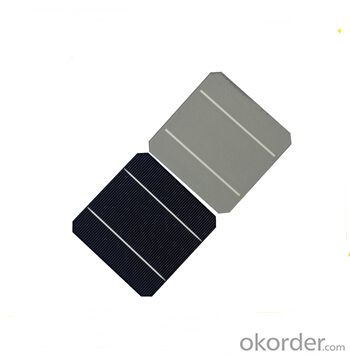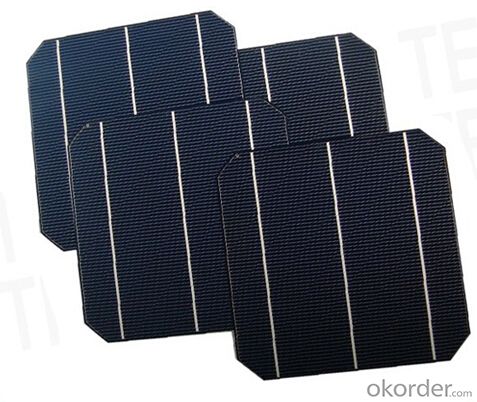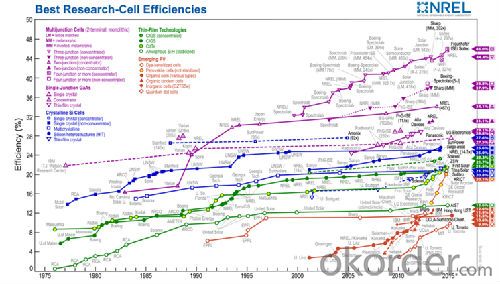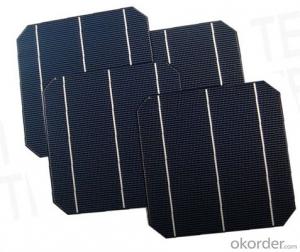Monocrystalline 156 mm X 156 mm Solar Cells supplier from China
- Loading Port:
- Shanghai
- Payment Terms:
- TT or LC
- Min Order Qty:
- 5000 pc
- Supply Capability:
- 80000 pc/month
OKorder Service Pledge
OKorder Financial Service
You Might Also Like
Brief Introduction of Solar Cells
A solar cell, is an electrical device that converts the energy of light directly into electricity by the photovoltaic effect, which is a physical and chemical phenomenon. It is a form of photoelectric cell, defined as a device whose electrical characteristics, such as current, voltage, or resistance, vary when exposed to light. Solar cells are the building blocks of photovoltaic modules, otherwise known as solar panels.
Advantage of Monocrystalline Solar Cells
• High efficiency and stable performance in photovoltaic conversion.
• Advanced diffusion technique ensuring the homogeneity of energy conversion efficiency of the cell.
• Advanced PECVD film forming, providing a dark blue silicon nitride anti-reflection film of homogenous color and attractive appearance.
• High quality metal paste for back surface and electrode, ensuring good conductivity, high pulling strength and ease of soldering.
• High precision patterning using screen printing, ensuring accurate busbar location for ease with automatic soldering a laser cutting.
Specifications of Monocrystalline Solar Cells
Format : 156 mm × 156 mm ± 0.5 mm
Thickness: 210 μm ±40 μm
Front (-) : 1.5mm bus bars (silver),blue anti-reflection coating (silicon nitride)
Back (+) : 2.5mm wide soldering pads (silver) back surface field (aluminium)
Efficiency (%) Pmpp (W) Umpp (V) Impp (A) Uoc (V) Isc (A) |
18.20% 4.43 0.536 8.263 0.634 8.712 |
18.00% 4.38 0.535 - 8.188 0.633 8.701 |
17.80% - 4.33 0.534 - -8.112 ---0.632 ----8.652 |
17.60% 4.28 0.533 8.036 0.631 8.641 |
17.40% 4.23 0.529 8.005 0.630 8.591 |
17.20% 4.19 0.525 7.973 0.627 8.542 |
17.00% 4.14 0.522 7.926 0.624 8.495 |
16.80% 4.09 0.518 7.893 0.620 8.452 |
16.60% 4.04 0.515 7.844 0.617 8.410 |
16.40% 3.99 0.514 7.765 0.616 8.373 |
16.20% 3.94 0.511 7.715 0.615 8.317 |
16.00% 3.89 0.509 7.650 0.613 8.251 |
Usage of Monocrystalline Solar Cells
Solar cells are often electrically connected and encapsulated as a module. Photovoltaic modules often have a sheet of glass on the front (sun up) side, allowing light to pass while protecting the semiconductor wafers from abrasion and impact due to wind-driven debris, rain, hail, etc. Solar cells are also usually connected in series in modules, creating an additive voltage. Connecting cells in parallel will yield a higher current; our solar cells have passed IEC Certification. With high and stable quality, our cells can greatly improve the performance of Solar Modules.
Packaging & Delivery of Monocrystalline Solar Cells
Carton Box Package and Deliver by air. It should be noticed that it should be avoid of water, sunshine and moist.



FAQ
We have organized several common questions for our clients,may help you sincerely:
①What price for each watt?
It depends on the efficiency of the solar cell, quantity, delivery date and payment terms.
②How long can we receive the product after purchase?
In the purchase of product within three working days, We will arrange the factory delivery as soon as possible. The pecific time of receiving is related to the state and position of customers.Commonly 7 to 10 working days can be served.
③Can you provide the peripheral products of the solar panels, such as the battery, controller, and inverter? If so, can you tell me how do they match each other?
Yes, we can, we have two companies for solar region, one is CNBM International, the other is CNBM engineering Co.
We can provide you not only the solar module but also the off grid solar system, we can also provide you service with on grid plant.
④What is your warranty of solar cell?
Our product can promise lower than 0.3% open box crack, we support claim after opening the box if it has crackm color difference or sth, the buyer should give pictures immediately, we can not accept the claim after the solar cell has assembled to solar panel.
• Timeliness of delivery
• ⑤How do you pack your products?
We have rich experience on how to pack the solar cell to make sure the safety on shipment, we could use wooden box or pallet as buyer's preference.
⑥ Can you do OEM for us?
Yes, we can.
Research direction of solar cell supplier
Now what solar cells suppliers are researching for? I think we all know the past few years, the photovoltaic industry in a slump, the reason that the industry cannot get rid of supporting policies is that the production costs are too high, so now all of them are desperately looking for a low-cost solar cell system, in the early stage of new materials or even tolerate its efficiency is very low. These low-cost battery can be attributed to the third generation of solar cells in the family, but also the story from 20 years ago talking about: the first line is the year Kodak has not closed down, a Chinese researcher found that organic dyes can also produce the photoelectric effect. Then European scholars dioxide nanoparticles staining, actually made an 8% efficiency solar cell chemistry, which is a dye-sensitized cells, 13% of the world record two years ago after the last time he climbed nature almost extinct from academia. The second line is a conductive organic Nobel Prize, we have to study photoelectric conversion, electric light switch or is organic led display, commercial very successful, who knows dynasty transfer power (that is, the solar cell) was actually a pit. But the Nobel laureate is still hopeful to open an organic photovoltaic company to give the Clinton administration's strong support; the result has been wiped out in order get the 2008 financial crisis. The battery has just broken the world record 10% of it. The third line is to make dye-sensitized cells found in the Japanese organic-inorganic hybrid material which can replace the perovskite structure of the dye, the efficiency of 3%. Europeans found that the material itself is a good photovoltaic semiconductor material, is now the world record by the Korean remained at 20%, last month issued a science. These three lines of batteries are the order of the temperature at room temperature with a chemical solution can be synthesized, lower cost than silicon cells, the question is not high enough efficiency lifetime is not long enough, but due to the relatively low barriers to entry (chemical laboratory on the line) Therefore worldwide research group particularly impact factor in the field have gone.
Now what solar cells suppliers are researching? Simply put, that is efficient and cost. Close to the production of research and development, the first is the original laboratory can efficiently process into mass production process, such as PERC, HIT, IBC, etc; more front-end development, is looking for more efficient and lower cost of battery cells materials, such as laminated battery, battery perovsk

- Q:Can solar cells be used for powering transportation infrastructure?
- Yes, solar cells can be used for powering transportation infrastructure. Solar-powered electric vehicles, such as solar cars, solar buses, and solar trains, are already being developed and deployed in various parts of the world. Additionally, solar energy can also be used to provide power for charging stations and electric vehicle infrastructure, reducing reliance on traditional energy sources and promoting sustainability in transportation.
- Q:What is the cost of producing a solar cell?
- The cost of producing a solar cell can vary depending on various factors such as the type and quality of materials used, manufacturing processes, scale of production, and market conditions. However, advancements in technology and economies of scale have significantly reduced the cost of solar cell production over the years. On average, the cost of producing a solar cell can range from a few cents to a few dollars per watt.
- Q:What is the impact of dust and dirt on solar cell performance?
- The presence of dust and dirt on solar cells can significantly impact their performance. These particles can accumulate on the surface of the cells, reducing the amount of sunlight that reaches the photovoltaic material. This reduces the efficiency of the solar cells in converting sunlight into electricity. Dust and dirt can also create shadows on the cells, causing hot spots and leading to uneven distribution of power production. Therefore, regular cleaning and maintenance of solar panels are crucial to maximize their performance and ensure optimal energy generation.
- Q:Can solar cells be used in industrial applications?
- Yes, solar cells can be used in industrial applications. They are increasingly being integrated into industrial processes to generate clean and renewable energy for powering machinery, equipment, and facilities. Solar cells are utilized in various industrial sectors such as manufacturing, agriculture, mining, and logistics, contributing to reduced carbon emissions and operational costs.
- Q:What is the impact of snowmelt on solar cell efficiency?
- The impact of snowmelt on solar cell efficiency is generally positive. Snow on solar panels can reduce their efficiency by blocking sunlight and preventing the cells from generating electricity. However, when snow melts, it cleans the panels and allows them to receive more sunlight, thus increasing their efficiency.
- Q:How can I explain to my 10 year old daughter what solar cells are?
- I had the same question from my son when he was 11 years old. All I did was I took him to the National Electricity museum, and it explains everything about solar cells.
- Q:Can solar cells be used for cooking?
- Yes, solar cells can be used for cooking, but not directly. Solar cells generate electricity from sunlight, which can then be used to power electric stoves or other cooking appliances.
- Q:What is the role of tracking systems in solar cell installations?
- The role of tracking systems in solar cell installations is to optimize the amount of sunlight that reaches the solar panels throughout the day. These systems continuously monitor the position of the sun and adjust the orientation and tilt of the panels accordingly. By tracking the sun's movement, the panels can capture more sunlight and generate higher energy output, increasing the overall efficiency of the solar cell installation.
- Q:What is the role of batteries in solar cell systems?
- The role of batteries in solar cell systems is to store the excess energy generated by the solar panels during the day, so it can be used during periods of low sunlight or at night. This helps ensure a continuous and reliable power supply from solar energy.
- Q:How do solar cells perform in areas with high levels of pollen?
- Solar cells can be affected by high levels of pollen in certain ways. Pollen, when accumulated on the surface of solar panels, can reduce their efficiency by blocking sunlight from reaching the cells. This reduction in efficiency can result in a decrease in the overall energy generation of the solar panels. Hence, it is important to regularly clean and maintain solar panels in areas with high pollen levels to ensure optimal performance.
1. Manufacturer Overview |
|
|---|---|
| Location | |
| Year Established | |
| Annual Output Value | |
| Main Markets | |
| Company Certifications | |
2. Manufacturer Certificates |
|
|---|---|
| a) Certification Name | |
| Range | |
| Reference | |
| Validity Period | |
3. Manufacturer Capability |
|
|---|---|
| a)Trade Capacity | |
| Nearest Port | |
| Export Percentage | |
| No.of Employees in Trade Department | |
| Language Spoken: | |
| b)Factory Information | |
| Factory Size: | |
| No. of Production Lines | |
| Contract Manufacturing | |
| Product Price Range | |
Send your message to us
Monocrystalline 156 mm X 156 mm Solar Cells supplier from China
- Loading Port:
- Shanghai
- Payment Terms:
- TT or LC
- Min Order Qty:
- 5000 pc
- Supply Capability:
- 80000 pc/month
OKorder Service Pledge
OKorder Financial Service
Similar products
New products
Hot products
Hot Searches
Related keywords




























